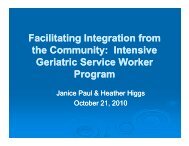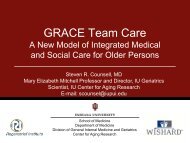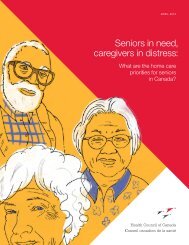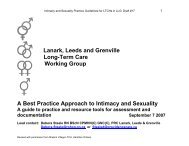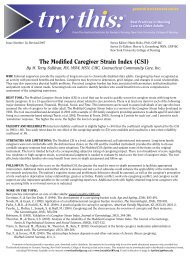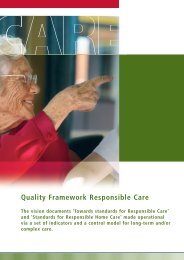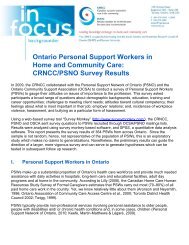Community Care Common Standards Guide - Department of Health ...
Community Care Common Standards Guide - Department of Health ...
Community Care Common Standards Guide - Department of Health ...
- No tags were found...
You also want an ePaper? Increase the reach of your titles
YUMPU automatically turns print PDFs into web optimized ePapers that Google loves.
OVERVIEW OF THE GUIDE SECTION 1Currently the Australian Government provides approximately 60 per cent <strong>of</strong> funding for the program andmaintains a broad strategic policy role. The State and Territory governments provide the remainingfunding and are the primary points <strong>of</strong> contact for the program’s service providers and service users. TheState and Territory governments are also responsible for program management, including the approvaland funding <strong>of</strong> individual HACC Program services in their jurisdictions.All governments, with the current exception <strong>of</strong> the Victorian and Western Australian State Governments,have agreed that the Australian Government will have full policy and funding responsibility for the agedcare component <strong>of</strong> the HACC Program from July 2011 and will take on administrative responsibility fromJuly 2012.1.4.2 Packaged <strong>Care</strong> Programs<strong>Community</strong> Aged <strong>Care</strong> Packages (CACPs)Since 1992 the Australian Government has provided individually tailored packages <strong>of</strong> community aged careservices, in the form <strong>of</strong> CACPs, designed to meet the needs <strong>of</strong> frail older people with complex care needswho wish to remain living in their own homes. To be eligible to receive a CACP, the service user must firstbe assessed by an Aged <strong>Care</strong> Assessment Team (ACAT) (Aged <strong>Care</strong> Assessment Service (ACAS) inVictoria) as having complex care needs that can only be met by a coordinated package <strong>of</strong> care services.They would be otherwise eligible for at least low level residential aged care while preferring and being ableto remain at home.CACPs are very flexible and are designed to meet each individual’s care needs. The types <strong>of</strong> services thatmay be provided as part <strong>of</strong> a CACP include:• Personal care• Social support• Transport to appointments• Home help• Meal preparation• Gardening.Extended Aged <strong>Care</strong> at Home (EACH) Packages and Extended Aged <strong>Care</strong> at Home Dementia(EACHD) PackagesEACH and EACHD packages are individually planned and coordinated packages <strong>of</strong> care, tailored to providefor the complex care needs <strong>of</strong> older people to assist them to remain living at home. EACHD packages focuson providing high-level care for service users who have been assessed as experiencing behaviours <strong>of</strong>concern and psychological symptoms associated with dementia. EACH and EACHD packages are funded bythe Australian Government. To receive an EACH or EACHD package, a person must be assessed by anACAT (ACAS in Victoria) as requiring high-level care. The types <strong>of</strong> services that may be provided as part <strong>of</strong>an EACH or EACHD package include:• <strong>Care</strong> provided by a registered nurse• <strong>Care</strong> provided by an allied health pr<strong>of</strong>essional, such as a physiotherapist, podiatrist or other type <strong>of</strong>allied health care• Personal care• Transport to appointments• Social support• Home help• Assistance with oxygen and/or enteral feeding.1.4.3 National Respite for <strong>Care</strong>rs Program (NRCP)The NRCP is one <strong>of</strong> several initiatives designed to support and assist relatives and friends caring at homefor people who are unable to care for themselves because <strong>of</strong> disability or frailty. This program is funded bythe Australian Government, and assists by arranging respite when carers need to take a break fromCOMMUNITY CARE COMMON STANDARDS GUIDE Page | 3



